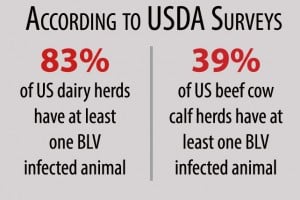BLV Testing
Bovine Leukosis (BLV)
- Blood-borne viral infection with no effective vaccine
- Negatively impacts production, longevity, and cull value
- Screen cows by ELISA then submit samples from BLV-positive cows for AntelBio™️ STRATA-G™️ BLV PCR testing
- The AntelBio™️ STRATA-G™️ BLV PCR test can identify susceptible cows that have become “Super Shedders,” causing the most risk to uninfected herdmates and youngstock.

Sample Types
- Milk, individual (fresh, frozen or preserved)
- Serum (ELISA)
- Whole Blood (AntelBio™️ STRATA-G™️ BLV PCR or ELISA)
WHEN TO USE
- Test milk at dry-off or freshening
- Test serum by ELISA on animals over 6 months
- Test whole blood by AntelBio™️ STRATA-G™️ BLV PCR at any age
- Understand your herd’s risk with a BLV Herd Profile. To establish prevalence, test milk samples (DHI or hand-stripped) of the 10-most-recently-fresh cows in the first, second, third and fourth and greater lactation groups.
Results
- ELISA results available within 5 business days of sample receipt
- Reported as Positive, Negative or Suspect
- Suspect ELISA results should be retested
- AntelBio™️ STRATA-G™️ BLV PCR results available within 10 business days of sample receipt
- Reported as High, Moderate, Low, or Undetected with a numeric value indicating the number of BLV copies per white blood cell.
Milk Samples:
- Animals that are within 7 days of freshening have a high probability of giving false positive results when tested because of the presence of colostral antibodies.
- A suspect result for the Milk ELISA may indicate carryover from a previous Leukosis positive cow in the milking string and should be retested with a hand-stripped sample.
| Test Type | Positive | Negative | Suspect |
|---|---|---|---|
| Milk ELISA | >0.3 | <0.1 | 0.1 – 0.3 |
| Blood ELISA | >1.0 | <0.5 | 0.5 – 1.0 |
Price
- Individual ELISA (milk, blood) $6.50/sample
- Individual AntelBio™️ STRATA-G™️ BLV PCR $12/sample
- Testing billed upon sample receipt
- $10 sample submission fee per order
Additional Information
CentralStar’s laboratories provide sample analyses on milk, blood, fecal, and tissue samples for a variety of production, disease and health-related traits. More than 6 million samples are processed annually using state-of-the-art equipment and techniques including infrared spectroscopy, flow cytometry, ELISA, PCR, and more.
Note: The SS1 qPCR BLV test has been renamed, the AntelBio™️ STRATA-G™️ BLV PCR.
Diagnostic tests are intended to identify diseases for animal health, and do not determine the “safety” of milk.
